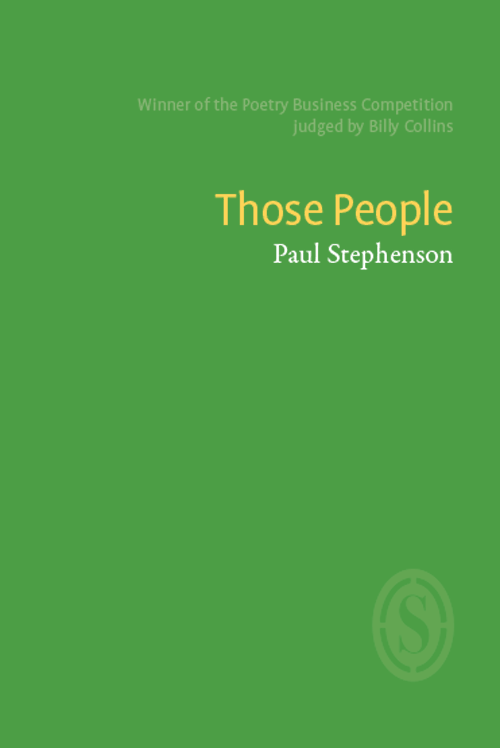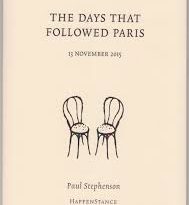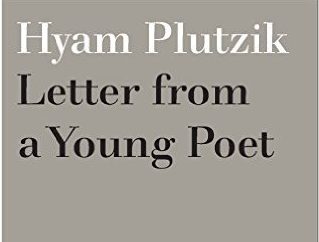Those People by Paul Stephenson
– Reviewed by Anthony Costello –
Those People recently won the Poetry Business Competition, one of the premier pamphlet competitions in the UK. Winning this is a massive boost to a poet’s confidence and career. Run by Peter and Ann Sansom, Poetry Business has become a credible arbiter of taste in England, aided by the commissioning of high profile judges: Simon Armitage, Carol Ann Duffy and last year, Billy Collins. As editors and publishers, the Sansoms sift though initial manuscripts submitted, perhaps allowing through to the final judge work that mirrors their own ars poetica, and the winning pamphlet is published by Smith/Doorstop in a format now resembling a brand, evident in a line of winners from Ed Reiss’s Now Then (first stage winner) through James Carruth’s The Death of Narrative and Ben Wilkinson’s For Real to Paul Stephenson’s Those People.
These pamphlets do differ in content and style – Reiss’ work is more comical and surreal, Caruth’s grounded in narrative; Wilkinson’s tidal verse has a lyrical sweep and formal edge, Stephenson’s poetry is more meanderingly laconic – but they have in common a clear-eyed vision, economy (not a word is wasted), a honed and (perhaps) work-shopped formal spine, and a restrained elegance. They are clean-cut, mannered, assured, and pay due diligence to the importance of white space on the page, as elaborated by Glyn Maxwell in On Poetry.
The influential lineage of Poetry Business pamphlets is apparent in ‘Angel End’, the list of characters that colourfully and whimsically depict a place and time (“The Bilbys who did up the Old Vicarage. Dr Bilby / Who gave me 50p for Bob-a-Job after I moved a ton of / bricks from one corner of his drive to the other”) reminds me of Ed Reiss’s ‘Born in Bradford’, and James Caruth’s ‘These are Things I Know’. There is something of Reiss’s ‘Kaiser Cheese’ and ‘In Wundbridge Tells’ in Stephenson’s ‘Gare du Midi’, inverting word and letter order to isolate and observe language for comic effect. I also, at first glance, found in Stephenson’s work an identification, or association, with an aesthetic growing around the recent output of Sam Riviere and Jack Underwood.
It seems unusual to be talking about styles and movements and the zeitgeist in poetry in relation to a poet’s first pamphlet, but as I read ‘Wake Up And’, ‘Cab’ and ‘Telescope’ I thought of the economical playfulness with words and and novel handling of the picturesque in the aforementioned. The second stanza of ‘Telescope’ exemplifies:
He knocks using the knocker,
Calls us to the pavement
To squint a look, twist until sharp.
We take turns marvelling
In our street’s planetarium
At the full button moon
With hairline crack.
Other poems like ‘Arrangement’ and ‘Shopping’ share Underwood’s and Riviere’s attention to the foregrounding of a concise whimsical intelligence irrespective of subject matter, but there is a slightly surreal comic edge to ‘Do You Have any Questions?’ a list of thirty questions that parody learning and the education system. The first three and last three sentences below:
“What do we do with coats?
How much time will we have?
Can we finish our sentence?
Can we skip any questions?
Can we take away the questions?
Will we get last year’s questions?”
This playfulness is continued with a portrayal of a mysterious guest in ‘The Guest’ whose one eye is “a red foil bauble”, who appears “dented from storage” who sits in the “glow of the lights” and “we prodded him with the fire poker”. ‘The Guest’ and ‘Birthday Cards’, a poem about a would-be correspondence with a (now deceased) fat man in history, could have been written by the judge (Billy Collins) or, say, Charles Simic (and so the associations grow!).
There’d be a dog pushing a lawn mower,
Going round and round a rotary washing line
Of women’s smalls while the rope leash unwinds.
Well-trained to cut increasing circles of grass
And with no energy spent on the fat man’s part(2nd stanza of 5)
It has a laconic, urbane, winning manner associated with Collins, Simic, Riviere, Underwood, and Stephenson’s poetry. Riviere, Underwood and Stephenson, in their seemingly effortless way with poetic subject matter, sometimes make writing poetry look easy and it isn’t. The effect is a kind of off-poetry or near-poetry or new-poetry that is too inchoate to name indelibly. Sean O’Brien plumps for “faux-urbane” to explain a style of poetry that is guarded in its self-expression. I feel it is poetry exploring an ambition to draw riches from the benign.
Something about the title – Those People – irked initially. I thought it insignificant, weak, until, that is, reading ‘Glace’, ‘Ashby de-la-Zouch’, ‘Round the Block’ and the eponymous ‘Those People’. I now feel the title is perfect for a poetry that Stephenson could stand alone in promulgating, one I sought to name, but vainly grappled for; not slacker poetry, not dapper poetry, not flapper poetry, but a poetry that sits at an elevated position and quietly roars…novella poetry?
The ideal novella poet would be a manifestation of F. Scott Fitzgerald or Truman Capote or Christopher Isherwood (ideally a mix of all three). The novella poet, erudite and sophisticated, would sit at a bar drinking martinis and hold forth on, say, Cavafy, while never losing sight of the contemporary social scene in front of him and the world beyond his acute 20/20 vision.
In Glace, Madonna is Stephenson’s Daisy Buchanan or Holly Golightly. He reads an issue of Smash Hits and a factoid about Madonna hating glace cherries, then, in novella style, pontificates:
You can imagine her predicament
When it comes to cakes and cocktails
And, sometimes, on top of trifles.
She’s wary of glace, never blase.
Her doo-wop style pop shuffle
And third single from Like a Prayer
Was called Cherish, not Cherries,
The one where in the video
She’s writhing on the sand,
Ravished by the ocean – don’t ask
Me which ocean: the waves lapped
And there was foam. Pacific?
As for candid fruit generally
She can’t see the point, but then
Nor can I, if I can be candid.
The novella poet can be pop critic, then broaden his outlook to report sardonically on a social group and a way of life in ‘Ashby-de-la-Zouch’. We are told the townspeople are “a bit Belgian”, summer sales are on, and ” the men mostly chose / to work at Deloitte & Touche…”, …”chiselled women wear smiles / like snagged zips and la-di-la brooches” and children (“all called Zoe or Zack) / are cashed in at twelve”, while families slouch “in show homes on charcoal couches to watch/The Sound of Music together on mute”.
‘Round the Block’ is a tour de force in the tradition of poems (eg. ‘Redcastle Furze’, by Julia Webb) that take us on an image-rich “quick squizz” of a journey via place names to a cross-section of a poet’s childhood, but it is, finally, in ‘Those People’ – a poetic anthropological study of those people who arrive at parties early – that Stephenson reconnects with and announces his subject matter and his stylistic intent wholesale.
Those characters who eight hours later could be
Hitting Havana, sipping mojitos and dancing mambo
And rumba and salsa meringue with dollar-hungry
Doppelgangers of Che Guevara in desperate need
Of mechanical parts for dilapidated Dodges and
Chevrolets, but hey, instead, revel in the refuge
Of empty strip-lit galley kitchens, to sit on a ledge
Of marbled Formica, slurring into sausage rolls
And spilling their life…”
The novella poet notices everything, is honest – sometimes mercilessly so – is amusing and witty, and writes in a languidly elegant style with pitch perfect phrases. He can be undaunted, intelligent, charming, talented, and all things jazz.




